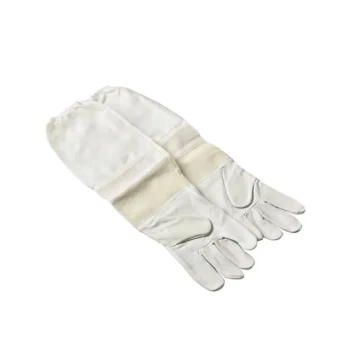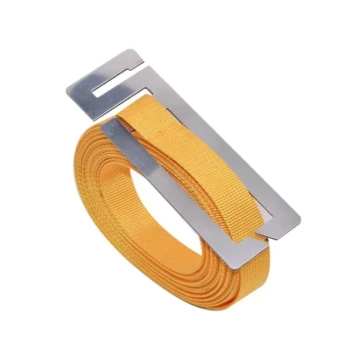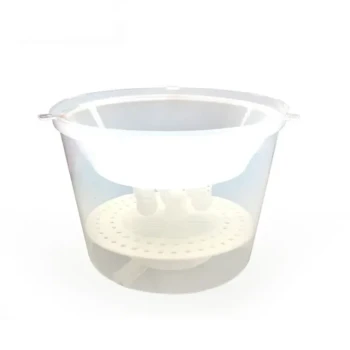For a beginner beekeeper, gloves are an essential piece of safety equipment. Their primary role is to protect your hands and forearms from stings, which is critical when you are still learning to handle hives calmly and confidently. This protection allows you to focus on your technique without the constant fear of being stung, creating a safer and more productive learning environment.
The central debate isn't whether gloves are useful, but rather when to prioritize maximum protection versus dexterity. For beginners, the choice is clear: safety and confidence-building must come first, making high-quality gloves a non-negotiable part of your initial toolkit.
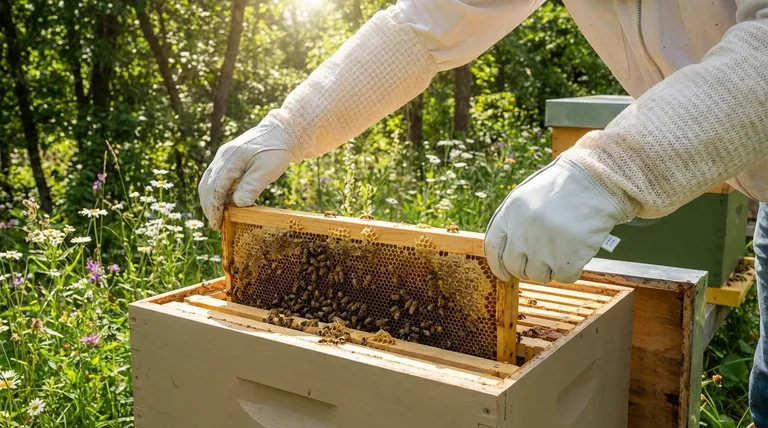
The Core Function: Your First Line of Defense
Proper beekeeping gloves serve several critical functions that are especially valuable when you are new to the craft. They are designed to be more than simple hand coverings.
Preventing Stings
Your hands are in the center of the action during a hive inspection, making them the most vulnerable part of your body.
Beginners often make fumbling or shaky movements that bees can interpret as a threat. Gloves provide a crucial physical barrier that mitigates this risk.
Building Confidence
The fear of being stung can cause jerky, nervous movements, which ironically increases the likelihood of agitating a colony.
By removing that fear, gloves allow you to move with calm, deliberate motions. This helps you learn proper handling techniques and keeps the bees calmer in the process.
Ensuring Full Coverage
Standard beekeeping gloves are not short. They include long sleeves, typically made of canvas, that extend up the forearm.
An elastic end ensures a secure fit over your beesuit, eliminating any gaps where a bee could enter.
Choosing the Right Material for Your Needs
The material of your glove directly impacts your experience, balancing protection, dexterity, and comfort.
Leather and Goatskin: The Gold Standard
These materials offer the best protection against stings and are highly durable.
Goatskin is a particularly popular choice as it is softer and more flexible than other leathers, providing a better feel and more dexterity while remaining highly protective.
Nitrile Gloves: The Middle Ground
Some beekeepers prefer thinner, disposable nitrile exam gloves. They offer significantly more "finesse" and tactile feedback.
However, they provide much less protection than leather. They are often used by beekeepers who have gained confidence and want more dexterity for delicate tasks.
Ventilated Gloves
For those working in hot climates, ventilated gloves are also an option. These typically incorporate mesh panels to improve airflow and keep your hands cool during long inspections.
Understanding the Trade-offs: Protection vs. Dexterity
The reason some experienced beekeepers forgo gloves is rooted in a fundamental trade-off. Understanding this is key to appreciating their role.
The Argument for Maximum Protection
For a beginner, the priority is safety. A bad stinging incident early on can undermine your confidence significantly.
Thick, durable gloves provide peace of mind, allowing you to handle frames and tools without hesitation.
The Loss of "Finesse"
The primary drawback of thick gloves is the reduced sense of touch. Experienced beekeepers rely on this tactile feedback to work delicately and avoid accidentally crushing bees.
Crushing a bee can release an alarm pheromone, which agitates the rest of the colony and can trigger a defensive response.
The Risk of Poor Habits
It's important to view gloves as a tool for learning, not a license for carelessness. Relying too heavily on their protection can lead to clumsy handling.
The goal is to use the safety they provide to practice the smooth, gentle movements that define good beekeeping.
Making the Right Choice for Your Goal
Selecting the right gloves depends entirely on your current experience level and primary objective.
- If your primary focus is maximum safety and confidence as a new beekeeper: Choose a durable pair of high-quality goatskin gloves that fit you well.
- If you are gaining confidence and need more dexterity for delicate tasks: Consider trying a single layer of heavy-duty nitrile gloves as an intermediate step.
- If your goal is to eventually work gloveless like some experts: Focus first on mastering calm, deliberate movements with your protective gloves, as this skill is the true foundation for safe beekeeping.
Your first pair of gloves is not just equipment; it's a tool that enables calm, confident learning on your journey as a beekeeper.
Summary Table:
| Glove Type | Best For | Key Benefits | Considerations |
|---|---|---|---|
| Leather/Goatskin | Beginners | Maximum sting protection, durable, builds confidence | Less dexterity, can feel bulky |
| Nitrile | Experienced Beekeepers | High dexterity, excellent tactile feel | Minimal sting protection |
| Ventilated | Hot Climates | Good airflow, keeps hands cool | Protection level varies by model |
Ready to Build Your Beekeeping Confidence?
As a beginner, the right gloves are your first step toward safe, successful beekeeping. HONESTBEE supplies commercial apiaries and beekeeping equipment distributors with high-quality, durable gloves designed for protection and long-term use. Our goatskin gloves offer the perfect balance of safety and flexibility to help you learn proper techniques with confidence.
Get in touch with our experts today to find the perfect protective gear for your apiary's needs. Let us help you build a solid foundation for your beekeeping journey.
Visual Guide
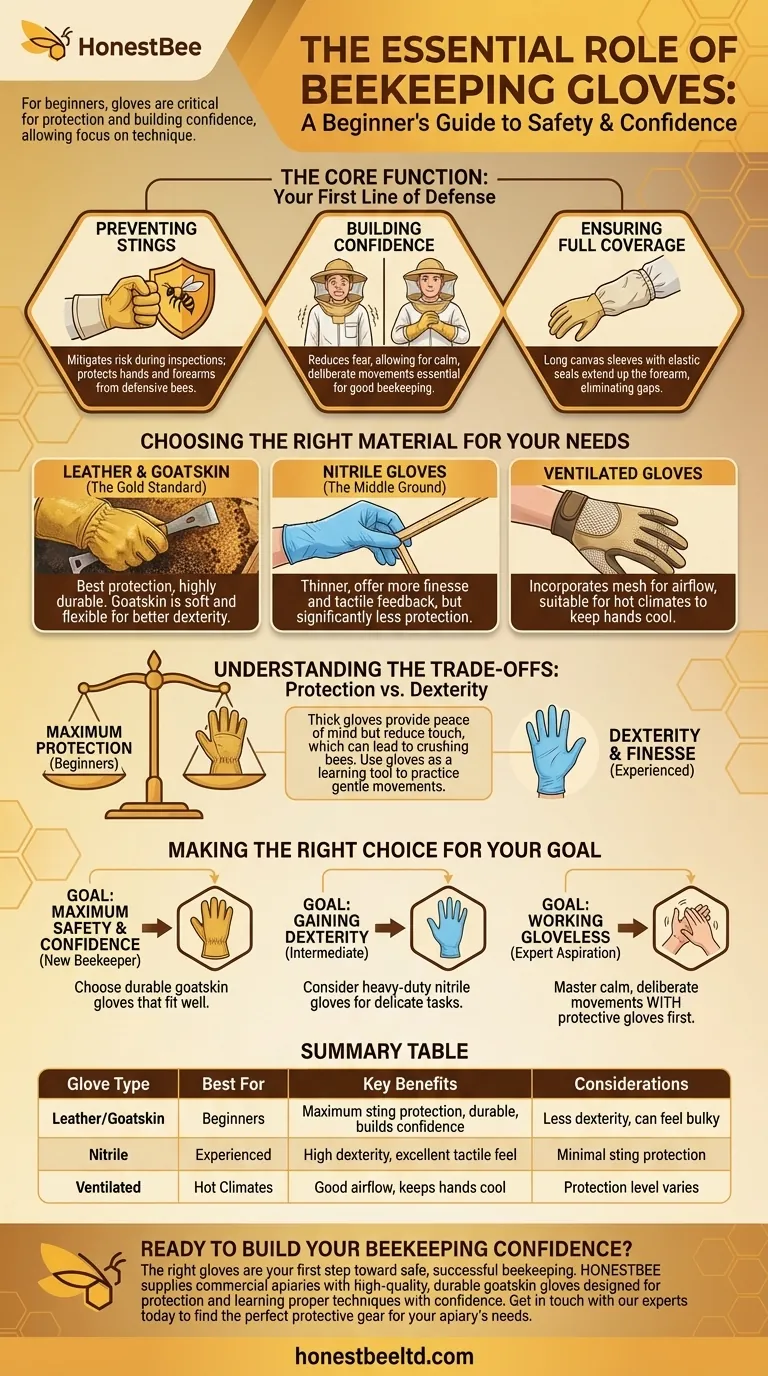
Related Products
- Mesh Ventilated 3 Layer Goatskin Beekeepers Gloves for Beekeeping
- Goatskin Leather Beekeeper Gloves with Vent Long Sleeve for Beekeeping Honey Bee Sting Proof Protection
- Goat Skin Leather Bee Sting Proof Beekeeping Gloves with Canvas Sleeve
- Professional Drop-Style Hive Handles for Beekeeping
- HONESTBEE Professional Long Handled Hive Tool with Precision Cutting Blade
People Also Ask
- What is the recommendation for beginning beekeepers regarding gloves? Build Confidence and Safety
- What factors should be considered when selecting beekeeping gloves? Balance Protection and Dexterity
- Why is it important to have gloves available even if not always worn? Essential Risk Management for Beekeepers
- Why do some beekeepers choose not to wear protective gear? Experience vs. Dexterity in Hive Management
- What should be considered when selecting beekeeping gloves? Find the Perfect Fit for Safety & Dexterity

